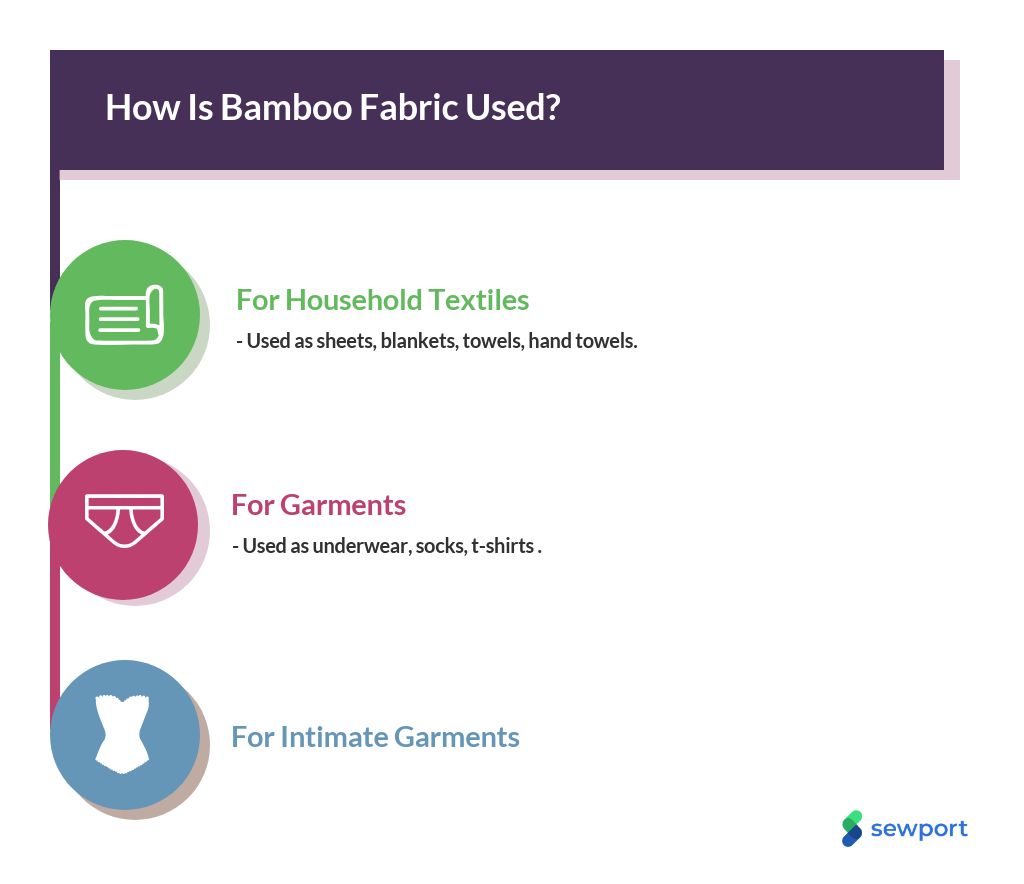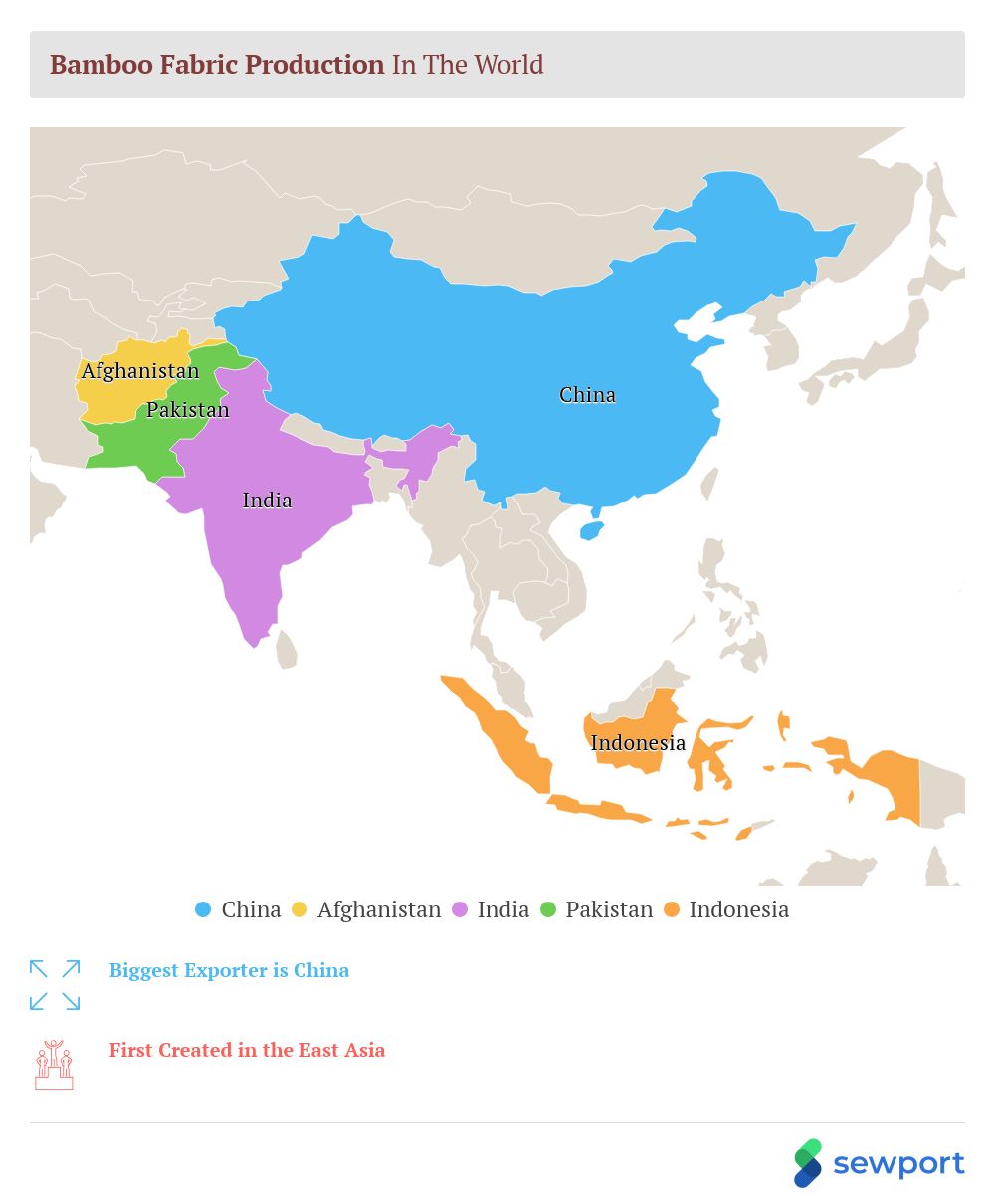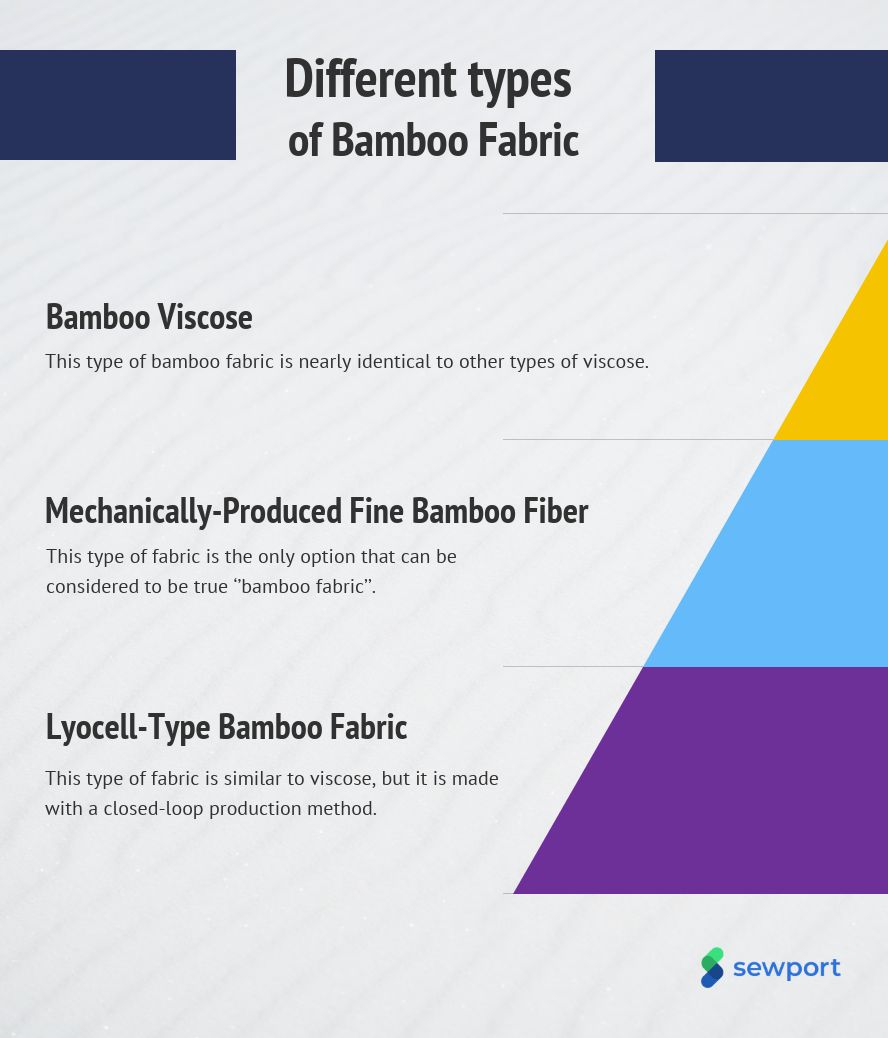| Fabric name | Bamboo fabric |
| Fabric also known as | Bamboo rayon, bamboo yarn, retting, bamboo linen |
| Fabric composition | Semi-synthetic viscose cellulose extracted from bamboo or yarn made from bamboo fibers |
| Fabric possible thread count variations | 300-600 |
| Fabric breathabilityn | Very breathable |
| Moisture-wicking abilities | High |
| Heat retention abilities | Medium |
| Stretchability (give) | High |
| Prone to pilling/bubbling | High |
| Country where fabric was first produced | Countries in East Asia |
| Biggest exporting/producing country today | China |
| Recommended washing temperatures | Warm |
| Commonly used in | Clothing and household textiles |
 Vintage Bamboo Fabric Green Chartreuse
Vintage Bamboo Fabric Green Chartreuse
What Is Bamboo Fabric?
The term "bamboo fabric" widely refers to a number of different textiles that are made from the bamboo plant. Fabrics have been made from bamboo for thousands of years, but it is only in contemporary times that the process of making this hardy and fast-growing wood into fabric has been perfected.
The story of bamboo fabric is a mixed bag. While some types of this fabric are environmentally sustainable and produced ethically, other types may be harmful to the environment or the workers who make it. To ensure that you select the right type of bamboo fabric, it's important to learn more about the textile industry surrounding this plant.
How Is Bamboo Fabric Made?

Depending on the type of fabric that is being made, bamboo textiles can be produced using a number of different methods. The majority of bamboo fabric produced worldwide is bamboo viscose , which is cheap to produce even though it has environmental downsides and represents workplace hazards.
Viscose is a term used to refer to any type of fabric that is made using the viscose method developed in the early 20th century. This type of fabric is one of the newest versions of rayon , which is a semi-synthetic fabric that was originally developed to mimic the desirable qualities of silk.
The process of producing viscose rayon is lengthy and involved, and it is incredibly wasteful. Any type of fabric made with tree cellulose produces a great deal of waste, but this waste can be handled sustainably when the right manufacturing processes are used. The waste produced by viscose rayon production, however, is contaminated with carbon disulfide , which is a toxic chemical that can cause a variety of health problems.
 Berkshire Hill Dash Stripe Bamboo Fabric
Berkshire Hill Dash Stripe Bamboo Fabric
Production of viscose rayon begins with the extraction of cellulose from wood pulp. Wood is broken down into tiny chunks, and it is then exposed to chemical solvents to remove the cellulose. Quite a few different processes are used to make viscose rayon, and almost all of them include additional harmful chemicals like caustic soda.
To produce a wearable fabric, extracted cellulose is compressed into sheets, exposed to carbon disulfide, and filtered. It is then pushed through a spinneret, which transforms the cellulose into strands. These strands are immersed in a vat of sulfuric acid to create filaments, and these filaments are then spun into yarn that can be woven into fabric.
Alternatively, bamboo cellulose can also be created with a closed-loop production process. Unlike the process used to create viscose rayon, closed-loop rayon production doesn't chemically alter the structure of the cellulose that is used, which results in a fabric that can be considered purely organic. While the solvent used to make traditional viscose rayon is wasted and usually ends up in the biosphere, the solvents used in closed-loop rayon production can be reused again and again, which significantly limits the environmental impact of this industry.
Bamboo fabric of the highest quality is made with production practices that do not extract cellulose. Instead, a natural enzyme is used on crushed bamboo wood fibers, and these fibers are then washed and spun into yarn. This yarn usually has a silky texture, and the fabric made by this process is sometimes called bamboo linen.
When bamboo fabric is made with this method, it is not environmentally harmful, and the resulting textile is strong and long-lasting. However, most types of bamboo fabric are not made with this mechanical process; to ensure that you're getting high-quality bamboo fabric, make sure that it is manufactured with a mechanical rather than a chemical process.
How Is Bamboo Fabric Used?

In general, this type of fabric can be used for practically every application in which cotton is used. Some consumers may even prefer this type of fabric to cotton due to its notable beneficial attributes.
For instance, bamboo fabric is highly breathable, and it is also stretchier than cotton. It's easy to weave this fabric into fabrics with high thread counts, and the resulting textiles are often thinner than their cotton counterparts while remaining similar or greater in tensility.
 Beige Embroidered Organic Bamboo fabric Dress
Beige Embroidered Organic Bamboo fabric Dress
Bamboo fabric may be used in sheets, blankets, towels, hand towels, or a number of other household textiles. Due to its softness and durability, however, this fabric is most commonly used in garments. Underwear made from this fabric is particularly popular, and socks, T-shirts, and other garments that make direct contact with the skin are commonly made with this fabric.
Some consumers prefer to use this type of fabric for intimate garments because of its purported antibacterial claims. However, research has indicated that the antibacterial properties for which bamboo is widely known are only majorly present in the raw product; once this type of wood has been processed into garments, these antibacterial benefits are mainly nonexistent.
It's important to remember that only bamboo fabric that has been made with mechanical processes will have the beneficial properties that make it desired by consumers. Bamboo rayon and similar semi-synthetic fabrics are not as soft or tensile as the real thing, and they certainly have negligible antibacterial benefits.
Where Is Bamboo Fabric Produced?

Bamboo fabric has been produced in East Asia for thousands of years. For instance, cultures in India and China have been producing this textile for untold generations, and bamboo fabric festivals are still held in rural India every year.
The relative environmental sustainability of growing this type of wood has stimulated the production of bamboo across the world. Producing this type of wood is even popular in Western nations such as the United States and Europe since it can be grown in a wide variety of climates. Therefore, almost every semi-developed or developed country in the world produces or exports at least some amount of bamboo fabric.
However, the single largest producer of this type of crop is China. In some ways, this economic fact is only natural; after all, bamboo has been an integral part of Chinese culture for millennia, and it has long been a favorite substance for making into textile products in this area.
There's also a darker side to why production of bamboo fabric is so popular in China. Since the late 1970s, China has become more and more popular among international textile corporations due to this communist country's lax environmental standards and rampant human rights abuses in the consumer goods production sector.
It remains the case that producing textiles and consumer products of all kinds is, in many instances, the cheapest in China, which has caused a variety of bamboo fabric manufacturers to gravitate toward this country for their production needs. Since Chinese companies are not highly incentivized to grow their products in an ethical or sustainable manner, production of this textile crop in China is more environmentally damaging than is reasonable or necessary, but it is undeniably inexpensive to produce bamboo fabric in this country.
Other major exporters of this fabric include India, Pakistan, and Indonesia. While a significant amount of this type of fabric is also produced in the United States, most of it is manufactured for domestic consumption, which means that it does not contribute to this country's exports.
How Much Does Bamboo Fabric Cost?
 Vintage Bamboo Fabric Natural Linen
Vintage Bamboo Fabric Natural Linen
Viscose or similar semi-synthetic fabrics made from this type of wood are generally less expensive than cotton. In some cases, this decreased cost is passed on to the consumer. Genuine bamboo fabric that is made using mechanical methods, however, is almost always more expensive than cotton, but it may be more affordable than forms of luxury cotton like Egyptian cotton, Pima cotton, and Supima cotton.
What Different Types of Bamboo Fabric Are There?

There are three main types of bamboo fabric. These variations include:
- Bamboo viscose: This type of bamboo fabric is nearly identical to other types of viscose. The only reason why bamboo is used in the production of this fabric instead of another type of wood is reduced manufacturing costs; the benefits of this fiber are not present in its viscose form, and consumers should be wary of the conflating this type of textile with true mechanically-produced bamboo fabric.
- Lyocell-type bamboo fabric: This type of fabric is similar to viscose, but it is made with a closed-loop production method. In addition, the chemical structure of the cellulose used to make this type of fabric is not altered in the production process, which means that it retains many of the beneficial qualities that are also noted in mechanically-produced bamboo fabric.
- Mechanically-produced fine bamboo fiber: This type of fabric is the only option that can be considered to be true "bamboo fabric." It is relatively expensive and time-consuming to produce, but it offers far greater benefits than the types of fabrics that are not produced via mechanical means. This type of bamboo fabric is very strong, durable, and soft.
How Does Bamboo Fabric Impact the Environment?
Bamboo is often touted as an eco-friendly fabric, and in some ways, this designation may be accurate. For instance, bamboo is incredibly easy to grow; it matures very quickly, and it can grow in areas that are not suitable for other crops. Therefore, the environmental impact of cultivating bamboo is relatively minimal in theory, and it's up to individual bamboo cultivators to ensure that their crop is obtained in a sustainable manner.
Ironically, the modern demand for bamboo led many Chinese manufacturers to fell forests of other trees to plant bamboo, which practically eliminates the environmental benefits of this crop. In the late 1990s, however, the Chinese Communist Party instated regulations prohibiting this behavior.
 Bamboo Fabric Biker Jeans – Khaki
Bamboo Fabric Biker Jeans – Khaki
Even if contemporary bamboo cultivation is relatively easy on the environment, the process of producing bamboo viscose is anything but environmentally friendly. While there is generally no risk of consumers encountering toxic chemicals when they wear or use bamboo fabric, a variety of dangerous substances are used to transform raw bamboo into the cellulose that is used to make rayon.
For instance, the lye used to transform bamboo wood into a substance suitable for cellulose extraction isn't usually reused. In addition, carbon disulfide is an integral aspect of the rayon production process, and it's impossible to recapture this toxic chemical once it has been used.
Bamboo production in developing nations, such as China, has encountered a great deal of controversy. For instance, many Chinese bamboo fabric factories expose their workers to the gaseous carbon disulfide that is emitted in the bamboo rayon production process.
Carbon disulfide is a neurotoxin, and it also causes organ damage. Workers who are exposed to this chemical can develop psychosis, liver damage, coma, and blindness, and this chemical can also cause heart attacks. While some factories may protect their workers from carbon disulfide, the legal limits of this substance that have been determined by the Chinese government are far above the safety threshold indicated by medical scientists.
 Bamboo Linen Fabric
Bamboo Linen Fabric
Unlike cellulose from many of the other trees that are commonly used for viscose rayon production, bamboo cellulose is suitable for closed-loop production processes. Therefore, fabrics similar to lyocell can be made with bamboo, and the lyocell production process doesn't produce any toxic waste.
However, the vast majority of bamboo fabric is rayon, which means that environmentally degrading processes are used to make this textile. It's important to point out that genuine bamboo fiber can be produced with methods that are not harmful to the environment. If you want to experience the benefits touted by bamboo fabric manufacturers, it's necessary to avoid bamboo viscose and choose genuine fibers or lyocell-like bamboo cellulose fabrics instead.
Bamboo Certifications Available

It is possible to have bamboo fabric that has been produced with mechanical means certified as organic. This fabric can receive this certification if the bamboo fibers used in its production were cultivated with means determined by the USDA or a similar regulatory agency to be environmentally sustainable and economically ethical.
Since bamboo fabric made with the viscose rayon process is transformed into a semi-synthetic substance, it is impossible for this substance to be considered organic. Be wary of companies that claim to offer organic bamboo rayon.
